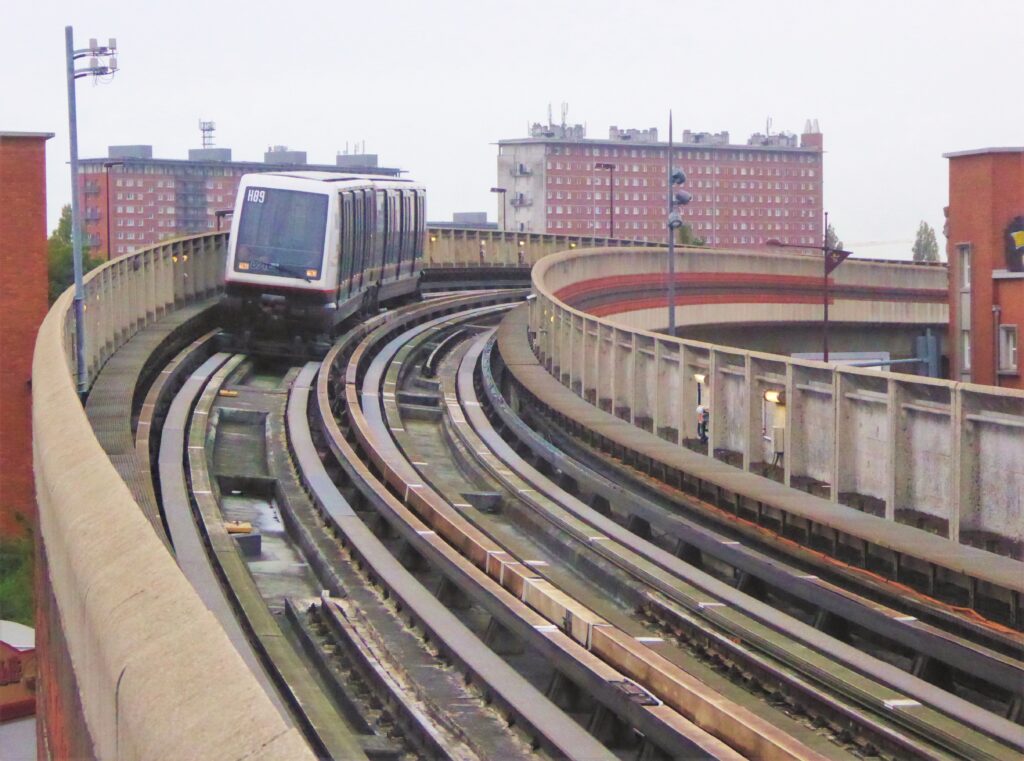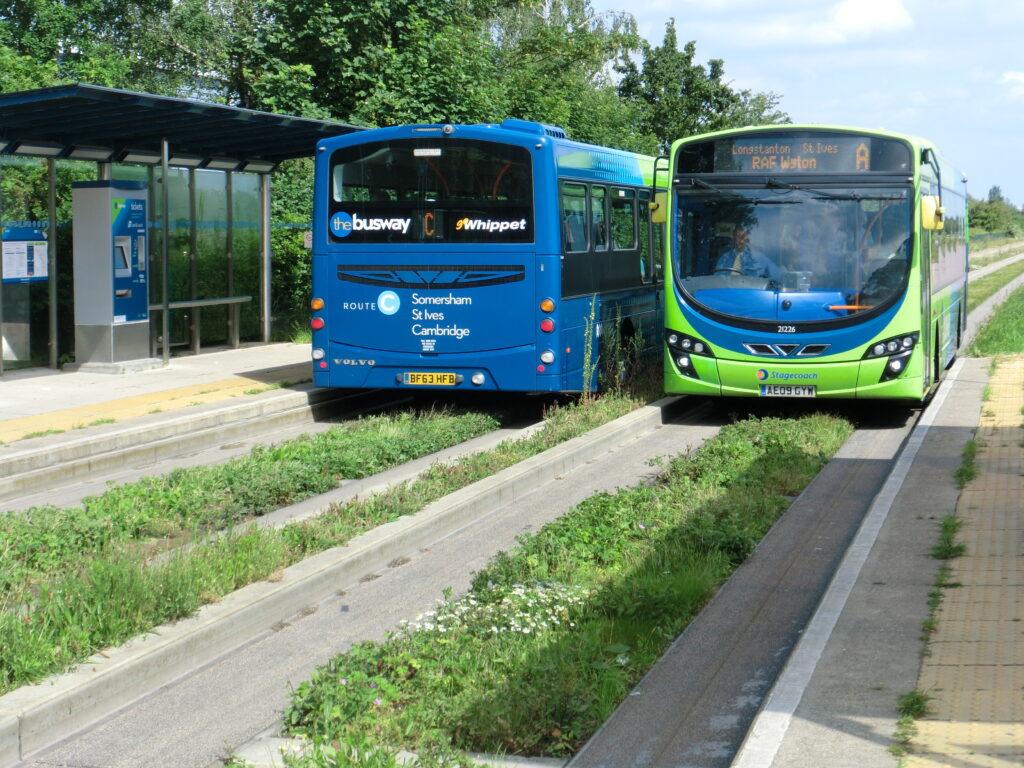“A railway is a transport system in which vehicles are carried and guided by rails”
This definition assumes that there are rails on which the vehicles run. The number of rails is irrelevant in this definition. We know systems with one, two and three rails where the vehicles rest on or hang from the rails, all of them are railways. Rails that are only used for propulsion, such as electric third rails and rack bars, are not included in the definition, just as the “air tracks” in which the vehicles hang on or ride upon taut cables are classified in a completely different category. Depending on shape, additional definitions, legislation or usage, the railways can also be named tramway, metro, funicular, monorail or else. Rails are made of many kinds of materials and are therefore manufactured in many kinds of ways. Rails were successively made of wood, combinations of wood with wrought or cast iron, natural stone, cast iron, wrought iron and steel and reinforced concrete. Today we only find steel for almost all railways, and concrete for some monorails and bus lanes.
Because the rails also have to guide the vehicles, they cannot simply be laid loose on the ground, but care must be taken that they are and remain at a fixed distance from each other. For this purpose, supports are (almost always) used on which the rails rest and to which they are attached. Just like the rails, these supports also have a long and varied history behind them. They are made of wooden planks and beams, of baked and dried clay, of natural stone, of cast iron and sheet iron, of asphalt, of rolled iron and steel, of reinforced or unreinforced concrete, reinforced or unreinforced plastics and nowadays also of sulfur concrete.
The many shapes and materials of both the rails and the supports have made the use of hundreds of types of rail fasteners necessary and desirable or even very necessary in the view of their inventors. If we multiply that by the number of formats, we would lose track very quickly. In other words, a certain classification is desirable in order to be able to distinguish certain lines of development. Fortunately, not all possible combinations have actually occurred (just think of the combination of wooden rails on steel or concrete sleepers). But there are still plenty left.
We should consider for a moment why so many different shapes and materials have been used. Several very different aspects play a role in this. First of all, we see the wide choice of materials we have today as “normal,” but that was certainly not the case several centuries ago. Although iron was known about a thousand years before Christ and was used for the production of all kinds of objects, it took until 1820 before any kind of railroad tracks could be rolled and until after 1850 before steel could be made from iron. Both were big steps forward. Something similar applies to concrete, an invention of the Romans, whose use on railways was mentioned in 1836 and which was attempted to make sleepers at the end of the 19th century. That did not really work until fifty years later, after the Second World War. An entirely different factor is the success of the railways, which in many cases proved to be a very efficient and sought-after transport system. This was already the case in the medieval mines, was continued on the public wooden British railways in the 17th century and came to universal recognition when from around 1800 the iron road began to conquer the world as a public means of transport. All the while, it was the same demands that were constantly being reinforced. It had to be faster, with heavier loads and cheaper, while less and less time could be allocated for maintenance. That has not changed since then, although comfort for travellers and local residents has recently been added.
In the development of the railway, the second industrial revolution (1870 – 1910, characterized by the emergence of industrial and economic superpowers) was certainly also of great importance for railway construction. At that time the railways were the pinnacle of technical development worldwide, while after 1930 the general belief that the fastening of railways should be elastic, ie with permanent pressing the rails onto the supports. This could not be achieved with the rail nails and coach screws used until then. The modern concrete sleepers soon brought the integrated fastening with them. Parts and provisions for elastic clamping of the rails are already fitted in the sleepers during their manufacture. Here we see the initiative for innovations shifting from the railway operators to the producers and suppliers of superstructure materials, with which private commercial interests will largely become decisive. After all, a sleeper with clamp holder A cannot be used for clamps type B!
Railways are constructed from a substructure, which consists of the formation, the structural works (bridges and tunnels) and facilities for the discharge of rainwater, with the superstructure on top of it. The superstructure consists from bottom to top of ballast, supports (sleepers or longitudinal beams, concrete slab) and rails. Security and energy supply are often included in this, but we will not go into that further. The materials used for the roadbed are not considered here either.
The function of the different parts of the railway is to transfer the point loads exerted on the rails by the wheels of the vehicles via the supports and the ballast bed as evenly as possible to the substructure. The function of the rail fastenings is to fix the rails to their supports so firmly that the track width is maintained and (nowadays) also to ensure that the rails cannot slip or twist on their support.“A railway is a transport system in which vehicles are carried and guided by rails”
This definition assumes that there are rails on which the vehicles run. The number of rails is irrelevant in this definition. We know systems with one, two and three rails where the vehicles rest on or hang from the rails, all of them are railways. Rails that are only used for propulsion, such as electric third rails and rack bars, are neglected in the definition, just as the “air tracks” in which the vehicles hang on or ride upon taut cables are classified in a completely different category. Depending on shape, additional definitions, legislation or usage, the railways can also be named tramway, metro, funicular, monorail or else. Rails are made of many kinds of materials and are therefore manufactured in many kinds of ways. Rails were successively made of wood, combinations of wood and wrought or cast iron, natural stone, cast iron, wrought iron and steel and reinforced concrete. Today we only find steel for almost all railways, and concrete for a few monorails and guided bus ways.
Because the rails also have to guide the vehicles, they cannot simply be laid loose on the ground, but care must be taken that they are and remain at a fixed distance from each other. For this purpose, supports are (almost always) used on which the rails rest and to which they are attached. Just like the rails, these supports also have a long and varied history behind them. They are made of wooden planks and beams, of baked and dried clay, of natural stone, of cast iron and sheet iron, of asphalt, of rolled iron and steel, of reinforced or unreinforced concrete, reinforced or unreinforced plastics and nowadays also of sulfur concrete.
The many shapes and materials of both the rails and the supports have made the use of hundreds of types of rail fasteners necessary and desirable or even very necessary in the view of their inventors. If we multiply that by the number of formats, we would lose track very quickly. In other words, a certain classification is needed in order to be able to distinguish certain lines of development. Fortunately, not all possible combinations have actually occurred (just think of the combination of wooden rails on steel or concrete sleepers). But there are still plenty left.
We should consider for a moment why so many different shapes and materials have been used. Several very different aspects play a role in this. First of all, we see the wide choice of materials we have today as “normal,” but that was certainly not the case several centuries ago. Although iron was known about a thousand years before Christ and was used for the production of all kinds of objects, it took until 1820 before a kind of railway rail could be rolled and until after 1850 before steel could be made from iron. Both were big steps forward. Something similar applies to concrete, an invention of the Romans, whose use on railways was mentioned in 1836 and which was attempted to make sleepers at the end of the 19th century. That did not really work until fifty years later, after the Second World War. An entirely different factor is the success of the railways, which in many cases proved to be a very efficient and sought-after transport system. This was already the case in the medieval mines, was continued on the public wooden British railways in the 17th century and came to universal recognition when from around 1800 the iron road began to conquer the world as a public means of transport. All the while, it was the same demands that were constantly being reinforced. It had to be faster, with heavier loads and cheaper, while less and less time could be allocated for maintenance. That has not changed since then, although comfort for travellers and local residents has recently been added.
In the development of the railway, the second Industrial Revolution (1870 – 1910, characterized by the emergence of industrial and economic superpowers) was certainly also of great importance for railway construction. At that time the railways were the summit of technical development worldwide, while after 1930 the general belief that the fastening of railways should be elastic, ie with permanent pressing the rails onto the supports. This could not be achieved with the rail nails and coach screws used until then. The modern concrete sleepers soon brought the integrated fastening with them. Parts and provisions for elastic clamping of the rails are already fitted in the sleepers during their manufacture. Here we see the initiative for innovations moving from the railway operators to the producers and suppliers of superstructure materials, with which private commercial interests will largely become decisive. After all, a concrete sleeper with clamp holder A cannot be used for clamps type B!
Railways are constructed from a substructure, which consists of the formation, the structural works (bridges and tunnels) and facilities for the discharge of rainwater, with the superstructure upon it. The superstructure consists from bottom to top of ballast, supports (sleepers or longitudinal beams, concrete slab) and rails. Security and energy supply are often included in this, but we will not go into that further. The materials used for the roadbed are not considered here either.
The function of the different parts of the railway is to transfer the moving point loads exerted on the rails by the wheels of the vehicles via the supports and the ballast bed as evenly as possible to the substructure. The function of the rail fastenings is to fix the rails to their supports so firmly that the track width is maintained and (nowadays) also to ensure that the rails cannot slip or twist on their supports.
Because they do meet the definition of a railway (carrying and guiding) but are slightly far away for most railway friends, they are mentioned and shown a bit more emphatically here. Beyond that, the metro-on-pneumatic tires and the guided bus way no longer appear on this website.


